No Room at the…Inn?
Was Jesus really born in a barn?
We’ve heard the story so many times we don’t even think about it anymore—Mary and Joseph were on their way to Bethlehem for the census when Mary went into labor. Joseph, in a panic, tried to find an inn for Mary to give birth, but all the Motel 6’s were booked up because everyone had come to town for the census. So they ended up in a stable, where Mary gave birth to Jesus, wrapped him in swaddling clothes, and laid him in a feeding trough. And there were cows mooing and sheep baaing, but otherwise, it was a silent night until the angels started singing and the shepherds showed up oohing and aahing, and then the wise men appeared with birthday presents.
In doing research for Mary’s story for The Ultimate Bible Character Devotional, I learned a slightly different story.
For one thing, the word “inn” used in most translations would more accurately be translated as “guest room.” While there might have been public inns in Bethlehem, it is more likely Joseph had relatives there since it was his hometown (and who would go to a public inn to have a baby?) If you know anything about Middle Eastern hospitality, you know that no one asking for shelter would be turned away, especially a family member.
Wealthy families had stables separate from their houses, but most people didn’t. They kept their animals—their sheep and goats—in the house, or at least in a section of the house that was a few steps lower than the main “family” room, right at the entry. So when you walked in the door, the first thing you saw were animals. (This may be why, in Judges 11, Jephthah was certain that when he came home, the first thing through the door to greet him would be an animal.)
Some houses also had separate guest rooms for visitors. It’s likely that Mary and Joseph arrived in Bethlehem to find that the guest room at the house they were staying in was already occupied, so they had to sleep in the main room with the rest of the family. When Mary went into labor, they chose to go to the “animal room” to deliver the baby for more privacy and to not disturb the rest of the family.
Notice I mentioned that Mary and Joseph were already in Bethlehem, not on the way, when Mary went into labor. Luke 2:6 says, “While they were there, the time came for Mary to give birth,” implying they were already in Bethlehem, possibly for several days. So there was no great rush to find a place to stay.
Mary did lay the newborn baby Jesus in a feeding trough. And yes, people had to have feeding troughs in their houses for their animals. David Croteau, in his book Urban Legends: 40 Common Misconceptions about the New Testament, explains how the feeding trough system worked in most houses, based on archeological evidence:
On the raised surface in the family room would be a feeding trough for the larger animals carved out of the floor. The larger animals in the animal area, like a cow or a donkey, could walk over and eat out of this trough.
The smaller animals, like sheep, would have a smaller manger that would be carved out of the floor in the animal room, or the family might have a wooden trough that could be brought inside.
If you think it odd that people kept their barn animals inside their homes, think about how they would look upon us keeping dogs inside our houses today. Dogs were considered dirty and dangerous creatures, while barn animals were extremely valuable—the average first-century family could not afford to lose them. It’s all a matter of perspective.
All this makes me wonder if I should change out the pretty nativity scene on my mantel for something a little more historically accurate. But these details don’t change the most important point of Jesus’ birth—that He stepped off the throne of heaven to enter the world in the lowliest and most humble of circumstances, as a helpless baby, laid in a feeding trough. Born in the animal room, to die a criminal’s death. Our God loved us so much that He did that.
Come, let us adore Him.
GINA DETWILER is the author of The Ultimate Bible Character Guide and The Ultimate Bible Character Devotional, published by Lifeway. She is co-author with Priscilla Shirer of the bestselling The Prince Warriors series. Her newest novella, Penny’s Journal: Fortune Lost, part of the Forlorn series, will be released in January.

